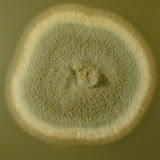 What you need:
What you need:1. A sealable sandwich bag
2. A piece of bread (I used some leftover porkchops, see photo on the right, covered with Pencillium sp.).
3. A paper towel
4. A little soil from outdoors or a potted plant
What you do (Part 1):
1. Place your bread in the bag. Dampen the paper towel and put it in the bag
with the bread and add a pinch of soil. The soil carries a few mold spores.
2. Let some air in the bag and zip it or tie it up so it's securely sealed. Label the
bag with the date and a name for your experiment, say, “Mold Test 1”.
3. Put the bags in a warm, dark place for about three days.
4. Look at the bread with a magnifying glass through the bag. If nothing has
happened after three days, wait three more.
5. Soon you’ll have a mold garden.
Very Important
THROW AWAY BAGS WITHOUT OPENING THEM WHEN FINISHED.
Breathing too much mold can make you sick. In dirt, mold is very spread out.
What’s happening?
Mold is not a kind of plant. Mold is not a kind of animal. Mold is a kind of fungus.
Fungi (FUN-jie) thrive by attaching themselves to a source of food. Famous
fungi include mushrooms, yeasts, mildews, and “athlete’s foot” fungus.
Mold is made up of millions of spores, or tiny microscopic seeds, all growing
together in a colony. Mold comes in a variety of furry, bright-colored blobseverything
from red to bright purple, depending on the type. The fuzzy-looking
spores weigh so little, tiny air currents can carry them through the air. When they
land someplace where the conditions are just right, they grow into new fungi.
Copyright 2001, Bill Nye and Nye Labs, LLC.All rights reserved.
